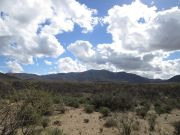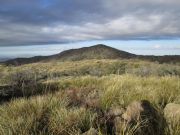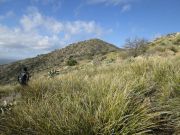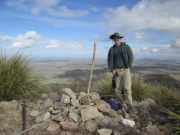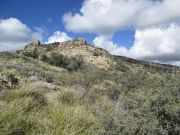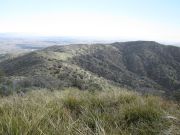
The Mountains of Arizona
• www.surgent.net
|
| Black Mountain |
• Possible Highpoint: Tortilla Mountains • Arizona State Trust Land • Pinal County |
|
Date: February 1, 2014
• Elevation: 5,587 feet
• Prominence: 1,907 feet
• Distance: 4.8 miles
• Time: 3 hours and 45 minutes
• Gain: 1,573 feet
• Conditions: Cold and brisk with clouds and wind
• Teammates: Scott Peavy
This particular Black Mountain is in Pinal County, north of the town of Oracle. The peak is the highpoint of the Tortilla Mountains, which are surrounded by private and state trust lands, slightly remote from everywhere. This depends on how the boundaries of the Tortilla Mountains are defined. Antelope Peak is sometimes considered the Tortilla Mountains' highest point. Scott Peavy and I were interested in it for one main reason: it being one of the top-100 peaks in Arizona by prominence.
The main issue with this peak was a lack of information getting close to it. The peak itself is on state trust land, but surrounding lands are private. The roads could be an issue, and I was never willing to bother driving to it, only to discover bad roads or locked gates. Besides, there are many other more interesting peaks to hike, so Black Mountain kept getting pushed to the back of the line.
We found some scant information that suggested the roads aren't as bad as feared. However, the report did mention the extreme brush. Nevertheless, we finally decided to hike this peak. I picked up Scott early in the morning, and drove us south along state route AZ-79 to Freeman Road, about 25 miles south of Florence. The sun was rising as we turned onto Freeman Road.
I followed Freeman Road east about 13 miles to Barkerville Road, another mile or so to Willow Springs Road, and south on that road to a side road leading up to a communications tower. Halfway up that road, we passed through a gate, placing us back onto state trust land. A little farther, the road splits, the left fork leading up to the tower. However, I went right, downhill to a corral. I parked a little beyond the corral, in a grassy clearing behind a concrete stock tank. To here, I had covered 23 miles from the highway, including one detour onto Janice Lane, which led to a locale named Oak Wells (as named on the map). However, this is posted and part of the Willow Springs Ranch. We talked to a couple guys out scouting for a hunt.
We were at 4,500 feet elevation, placing us just a thousand feet below the top, and about two air miles away. This meant a potentially short hike. The day was very cool and blustery, with low clouds. To the south, the Santa Catalina Mountains were socked in by these clouds, while above us we had high clouds and the occasional puffy, dark-colored clouds billow by. We started walking at 8:15 a.m.
We hiked up slope, aiming northwest toward a low ridge. The ground here was covered in prickly-pear cactus and general brush, but we were able to wind our way through this, often following cow paths. We gained onto the slopes and achieved this first low ridge fairly quickly. Our immediate goal was to get to Point 5327 on the main ridge, about one mile from the top. To get here, we hiked from hilltop to hilltop until we had gained onto this point, taking a little less than an hour. The going was generally easy, the brush moderate at worst. The main ridges are topped by big rocky outcrops, which made the navigation simple.
At Point 5327, we could see Black Mountain a mile west, but to get there, we would have to hike north and then west, following the main ridge lines. We did not lose much elevation on this long ridge walk. The brush closed in a little more, but most of it was bunchy beargrass, which is fairly easy to walk straight through. Woodier plants included madrone and mountain oak, plus occasional cat claw. There was relatively little cactus. There was always some path, but we had to zig-zag often. Some cow paths helped. At times we'd have no choice but to plow directly through, but these segments never went longer than a few yards.
This ridge walk went well. There seemed to be more bumps along it than the map would suggest. We managed very well to avoid the worst of the brush. In time, we were directly below the final 350-foot slope to the summit. By now, the brush had closed in. Being so close to the top, we traded style for economy and busted straight up the slope, pushing through the brush directly. It was tedious but short, and finally, we achieved the summit, arriving about 10:00 a.m., a hike of about one hour, forty-five minutes.
The top is open, and we sat near the summit cairn. The log sheets held a lot of names, but went back many years. In reality, it seems the peak is hiked at most once or twice a month, often by the Southern Arizona Hiking Club. The surrounding views were nice, but the low clouds blocked some of the ranges, and the winds had kicked up dust in the deserts below. Nevertheless, we could see the Catalinas, Galiuros, Pinal Peak, the Superstitions, Newman Peak, the Silver Bells and the Tortolitas. In clear, calm conditions, the views would be outstanding.
The stiff breeze up here was very chilling, the temperature in the 40s. We didn't stay long, wanting to get moving as soon as possible. The downhills were a little easier, since we could see ways through the brush that would not have been clear coming up. We stopped briefly at Point 5327, but got moving quickly, reaching my truck slightly after 12 p.m.. The downhill hake had taken us one hour, thirty minutes, our total time a shade under four hours.
Even back at the truck, it was breezy and cool. We changed into drier clothes but didn't linger. The drive out went well, and we stopped for photographs now that the sun was occasionally out. Back on AZ-79, we stopped at the Tom Mix Memorial about three miles to the north. Tom Mix was one of the first movie star cowboys, becoming famous in the 1920s and 1930s. He died in a car accident at this location in 1940. For the drive back to Scott's place, we detoured through Hunt Highway into Queen Creek and Gilbert. I had never been this way in all my years here. It's a mix of farm fields, desert, and tightly-packed housing subdivisions.
As always, I thank Scott for being a good hiking companion. We made good time and felt good about getting this peak done once and for all. It's not as grand a peak as many others in the state, and its remote location on state trust lands keeps visitation to a minimum, but the roads and actual hike weren't bad at all, and the brush not as bad as advertised. I've seen far worse on other peaks in Arizona (ahem, Weaver, ahem).
While navigation was fairly straightforward, we still had to pay attention to the ridges. There are more bumps and small ridges than the map suggests, and it would be easy to start down a ridge, e.g. aiming for the summit, then find oneself amid a thicket of dense growth. Coming back, we would be obliged to descend into thicker brush on the lower slopes to seek out the connecting saddles we needed to take to get back to my truck. In an absolute worst-case situation, the radio tower could serve as a failsafe. However, I would not suggest to park there, as the drop from that hilltop onto the main summit ridges involves what looked like some nasty, brushy slopes. The area near the corral worked nicely.
For me, this was my second Black Mountain hiked in less than a week, having hiked Black Mountain in Nevada this past Sunday with my mom. I think I'm up to about seven or eight "Black"s nationwide, which include mountains, peaks, buttes and mesas. It's obviously a very popular name, and an uncreative one. This peak is hardly black. I'm guessing someone named it while standing thirty miles away, viewing it while shaded.
|
|

